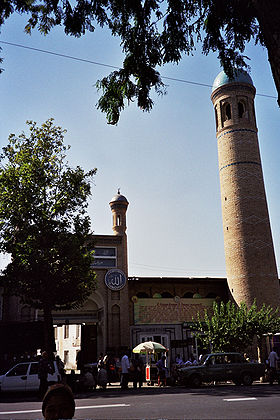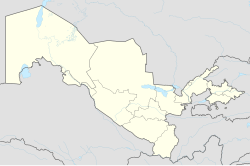
Back مرغلان Arabic مرجلان ARZ Mərğilan Azerbaijani مرغیلان AZB Margilan BAR Маргілан Byelorussian Margilan BS Margilan Catalan Маргилан CE Marg‘ilon CEB
Margilan
Marg‘ilon / Марғилон | |
|---|---|
Khonakhan Mosque and City Center aerial photo | |
| Coordinates: 40°28′16″N 71°43′29″E / 40.47111°N 71.72472°E | |
| Country | |
| Region | Fergana Region |
| Area | |
| • Total | 40.83 km2 (15.76 sq mi) |
| Elevation | 487 m (1,598 ft) |
| Population (2022)[1] | |
| • Total | 242,500 |
| • Density | 5,900/km2 (15,000/sq mi) |
| Postal code | 151100 |
| Area code | (+998) 73 |
| Website | www |
 | |
Margilan (Uzbek: Marg‘ilon/Марғилон, pronounced [marʁɨlɒn]; Russian: Маргилан) is a city (2022 pop. 242,500) in eastern Uzbekistan's Fergana Region.
Margilan is located in the south of the Fergana Valley, where trade caravans from China traveled westwards and vice versa during the days of the Silk Road. Margilan has been renowned for its silk goods as far back as the 10th century.[1][2]
According to legend, Margilan was founded by Alexander the Great. While stopping for lunch there, he was given chicken (murgh; in Persian: مرغ) and bread (nan; in Persian: نان), from which the town took its name. More reliable records indicate that by the 9th century Margilan was an important stop on the Silk Road, along the route going across the Alay Mountains to Kashgar.
In the early 16th century Babur, the founder of the Mughal dynasty, mentioned that "the pomegranates and apricots are superb .... the game in Margilan is good; white deer may be found nearby. The people are Sarts. They are a feisty people, ready with their fists. The custom of exorcism is widespread throughout Transoxiana, and most of the renowned exorcists of Samarkand and Bukhara are Margilanis. The author of the Hidaya (Burhan al-Din al-Marghinani) was from a Margilan village called Rishtan".[3] This reputation for toughness extends to modern times. Margilan merchants were key players in Central Asian commerce, and were said to be a law unto themselves during Soviet days, when the city was the heart of Uzbekistan's black market.[citation needed] Margilan today is also a stronghold of conservative Islam, as is much of the Fergana Valley.
- ^ "Hududlar bo'yicha shahar va qishloq aholisi soni" [Urban and rural population by district] (PDF) (in Uzbek). Fergana regional department of statistics.
- ^ "Margilan, Uzbekistan". Retrieved February 3, 2021.
- ^ The Babur-nama Trans. & Ed. Wheeler M. Thackston (New York) 2002 p5
© MMXXIII Rich X Search. We shall prevail. All rights reserved. Rich X Search



